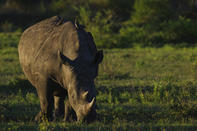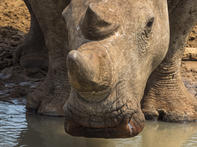Favoured Feeding Areas

White rhino have large elongated heads that terminate in a set of broad, square-shaped lips. The shape of the lips led to the naming of this rhinoceros as Dutch settlers referred to the ‘wyd’ mouth (meaning wide) and colonialists misinterpreted this to mean white.
The wide muzzle (20 cm) comprises a more sensitive upper lip (which is used to manoeuvre grass clumps into the mouth) and a hard lower lip (against which the top lip presses to severe the grass). Both lips are swiped upwards to effect the neat cropping of grass.
No incisors are involved at all in ingesting grass but broad, intricately enameled molars inside the cheeks provide a grinding surface for mastication. A rhino crops the grass continuously moving its head in a semi-circle and then stepping forward to repeat the action.
White rhinos maintain their own neatly cropped pastures in stands of favoured grass species (like Themeda triandra, Panicum maximum and Urochloa mossambicensis) which are often well concealed amongst taller grass. They rotate the use of their favorite feeding areas so as not to obliterate them.
Water is a Necessity

Because of the large quantity of fibrous grass that a rhino must consume to satisfy its energy requirements, it requires daily (if not twice daily) access to drinking water to assist with digestion. Rhino usually make their way to water late in the afternoon or even after dark.
Because of their reliance on water, bulls that do not have a water source within their own territory will have to leave their turf and enter other bulls’ territories in order to drink. So long as an intruding rhino behaves submissively, territorial bulls will tolerate water-related visits from neighbours. A bull rhino shows its submission by urinating in a stream (on his own territory he would spray).
He may also flatten his ears and squeal to reassure the territory owner of his innocuous intentions. If water is scarce, rhino can only go for up to four days without drinking. Rhinos practice geophagia (chewing of soil) to supplement minerals deficient in their all grass diet.
By Megan Emmett